Zdravím přátelé.
Hledali jsme turistické boty, které jsou kvalitní, dlouho vydrží, jsou kvalitně zpracovány z špičkového materiálu a byly za lidovou cenu.
Musíme se přiznat, že takovýchto bot jsme moc nenašli. Vždy to ztroskotalo na kvalitě bot. Hold za málo peněz, málo muziky.
Až nakonec v dlouhém testování a zvažování vyhrály Steinkogler Bergwacht.
Koupit si je můžete ZDE.
A proč vyhrály tyto boty?
Jsou šité norským šitím, která zajišťuje trvanlivost, odolnost a funkčnost.
Materiál je skvělý. Na svršek je použita FullGrain kůže, činěná chromtříslo činěním s úpravou waterproof, která zajišťuje dlouhou trvanlivost a vysokou voděodolnost i bez membrány.
Zároveň jsou boty svou tvrdostí v kategorii B. To znamená, měkké boty na lehkou turistiku, klidně celodenní, po lesních pěšinách a i mimo cesty. Určitě nejsou pro VHT a mačky. Takové ty ideální boty pro tuláky, turisty lovce, bushcraft a to vše za příjemnou cenu.
Pokud najdete kvalitnější boty, za lepší cenu, prosím napište mi..
Takto vypadají boty bez tkaniček a detail vodotěsného jazyku.
TECHNIKÁLIE:
- Velikost dámská: 43 (9)
- Váha jedné boty: 700 g.
- Výška, měřeno zevnitř: 140 mm.
- Celková výška: 175 mm.
- Dálka podrážky: 315 mm.
- Šířka podrážky: 103 mm.
- Délka vnitřní stélky: 280 mm.
- Tloušťka kůže svršku (FullGrain chromtříslo činěná): 2,5 mm.
- Podšívka: teletina 1,2 mm
- Přišití svršku k podrážce: Norské 2x šití.
- Cena 5800 Kč.
-
Výrobce: Steinkogler
- Kopit si je můžete ZDE.
OŠETŘENÍ NOVĚ KOUPENÝCH BOT
- Po rozbalení nových bot, vystříkám vnitřek boty Sprejem do bot.
- Svršek ošetřím krémem, který je na obuv nejlepší. Osobně radši používám náš vlastní Krém na kožené boty.
- U krému se snažte rozetřít, vetřít na kůži minimální film. Co nejméně krému, na co největší plochu. Krém používám Krém na koženou obuv.
- Takto nanesu 2–3 vrstvy, pokaždé se snažím krém rozetřít do minimálního filmu. Cokoli navíc je zbytečné.
- Případné oděrky barvy se nejlépe ošetří Krémem na boty v barvě bot, třeba od výrobce Saphir.
- Soustředím se na šití, kde se snažím krém protlačit skrz šití, aby se časem utěsnilo vůči vodě.
- Po každé procházce boty vyčistím kartáčem, vlhkým hadrem (voda, nebo Organotex) a na suchou kůži nanesu 1 – 2x Krém na kožené boty.
- Také po každém použití bot vytřu vnitřek boty vlhkým hadrem od potu, špíny.
- Boty dám na napínáky (ideálně cedrové).
- Boty jsou uložené v botníku do dalšího použití.
- Takto ošetřuji boty první měsíc po zakoupení, a to 1x týdně.
OŠETŘOVÁNÍ BOT PO PRVNÍM MĚSÍCI POUŽÍVÁNÍ
- Po každé procházce svršek boty vyčistím kartáčem, vlhkým hadrem (voda, nebo Organotex).
- Na suchý svršek (může být i po několika dnech, než boty vyschnou) nanesu rukou Krém na kožené boty (teplo rukou umožňuje lepší roztírání a krém lépe kůži ošetří).
- Také po každém použití bot vytřu vnitřek boty vlhkým hadrem od potu, špíny.
- Do vnitřku boty 1 – 2x měsíčně stříknu Sprej do bot.
- Boty mám na napínácích (ideálně cedrových) v botníku.
OŠETŘENÍ BOT PO PRVNÍM ROCE POUŽÍVÁNÍ
- Po prvním roce boty vyčistím kartáčem od nečistot.
- Svršek bot setřu od impregnace hadříkem s terpentýnem.
- Boty nechám vyschnout (1 den) od terpentýnu a potom je celé (zvenku i zevnitř) umyju pomocí kartáče teplou vodou s mýdlem na kůži. Nakonec je opláchnu teplou čistou vodou od vody s mýdlem.
- Po vyschnutí bot, natřu svršek obuvi 1x 100 % kondicionérem, který prohřeju v teplé vodě, aby obsah skleničky zprůhlednil. Jak svršek bot, tak i kožený vnitřek bot.
- Nechám boty 2 dny v klidu v teplé místnosti.
- Pokud je kůže pořád ztvrdlá, natřu ji ohřátým 100 % kondicionérem podruhé a nechám 1–2 dny v klidu v teplé místnosti.
- Pokud je kožená podšívka ztvrdlá, 1x natřu 100 % kondicionérem, který prohřeju v teplé vodě, aby obsah skleničky zprůhlednil.
- Nechám 1 den v klidu.
- Svršek rukou natřu Krémem na kožené boty a to ve 2-3 minimálních vrstvách.
- Vnitřek bot vystříkám Sprejem do bot.
- Jednou za rok celý proces opakuji.
- Po tomto důkladném vyčištění bot pokračuji v jejich ošetřování podle předchozího odstavce.
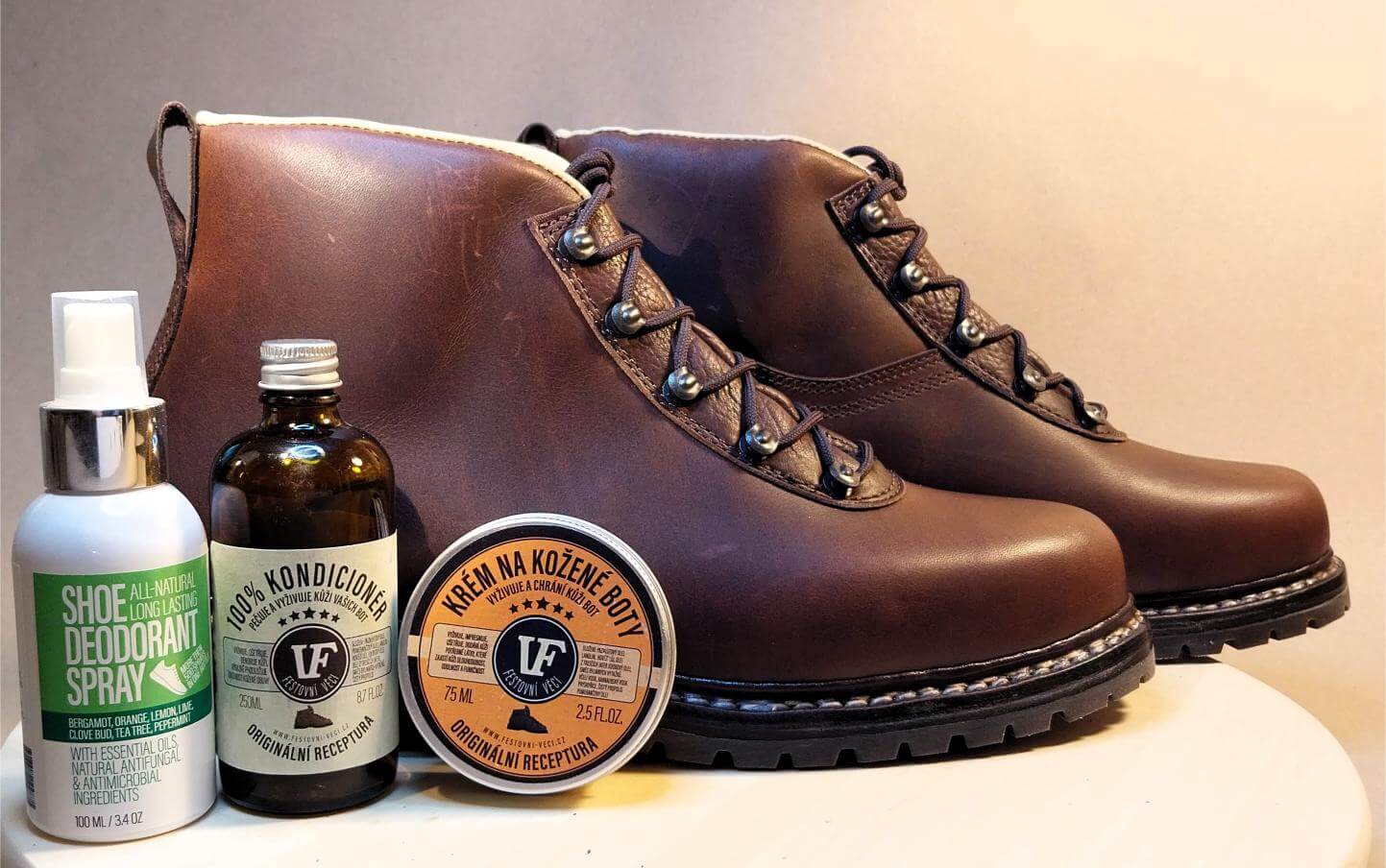
Srovnání starých a nových bot
Černé boty jsou ušité v roce 1960, hnědé boty jsou ušité Steinkogler v roce 2024 a jedná se o model Bergwacht.
Černé boty váží 890 g, hnědé boty váží 700 g. Jsou ve stejné velikosti.

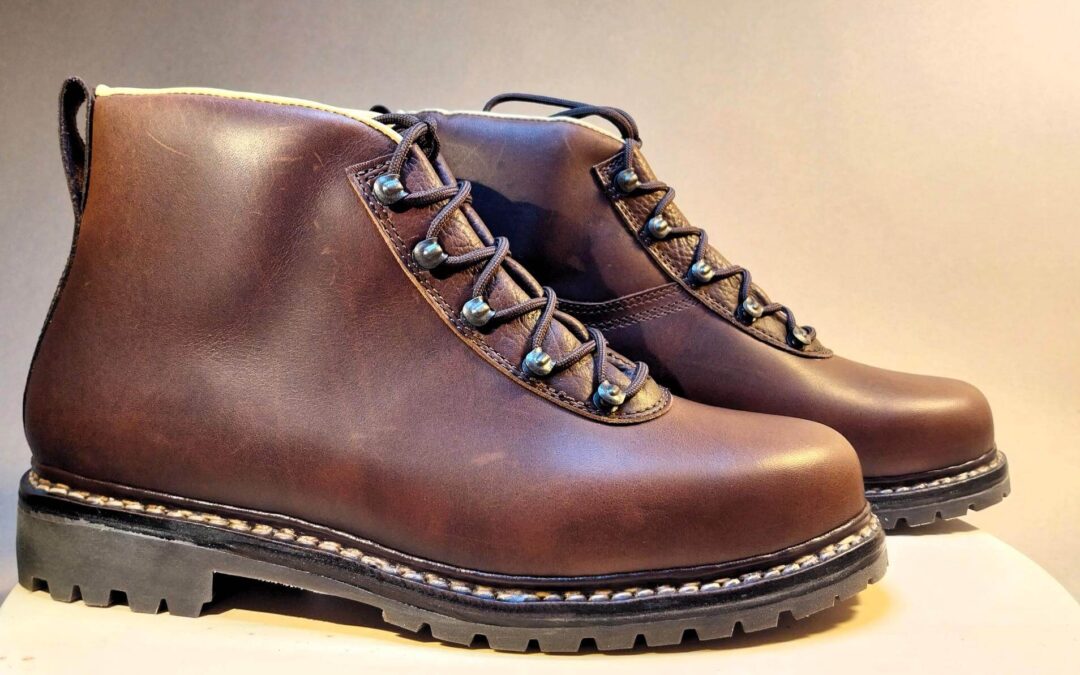
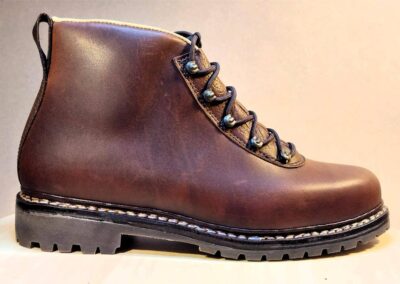
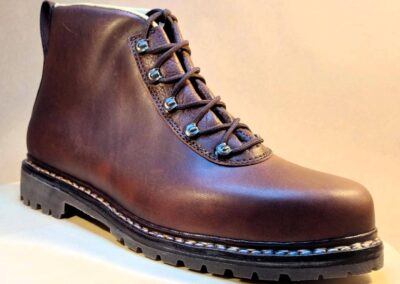
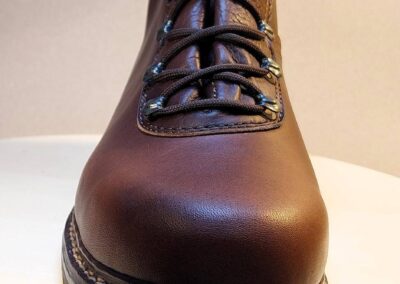
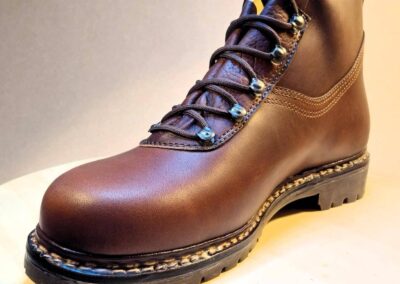
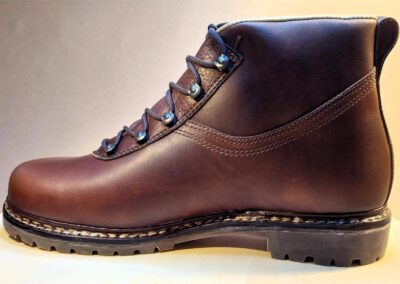
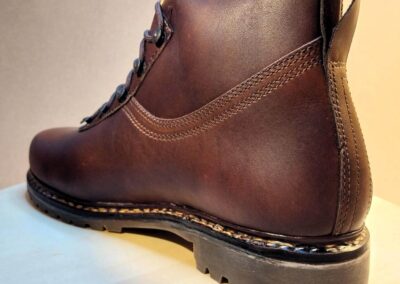
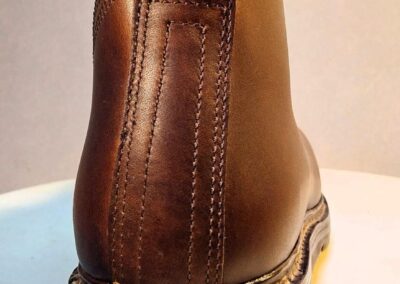
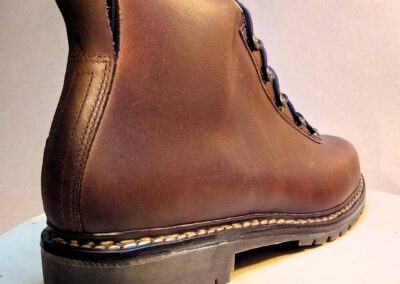
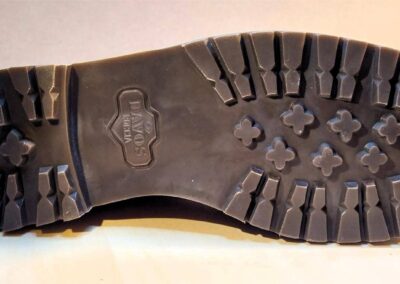
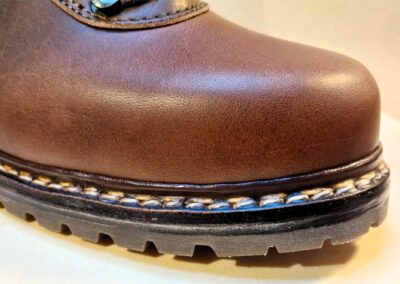

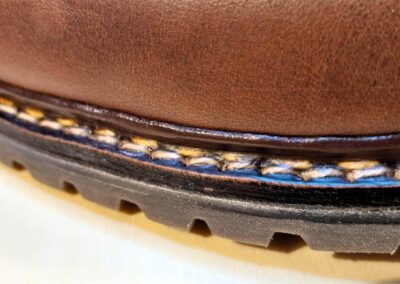
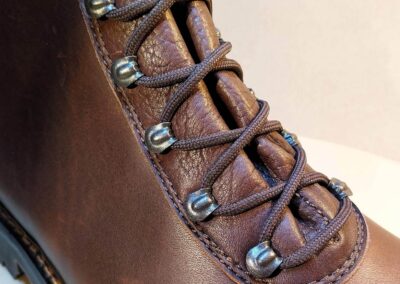
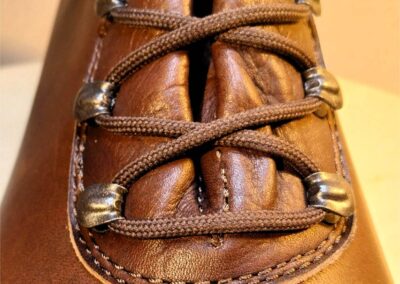
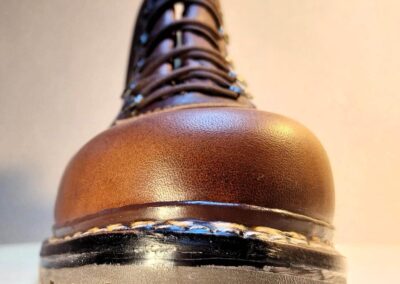
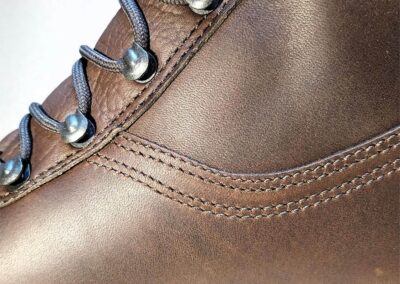
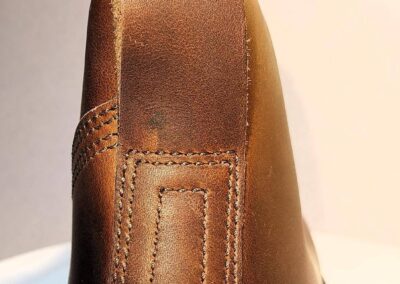
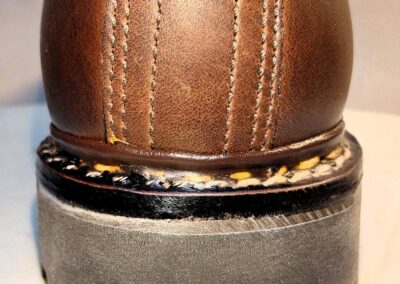
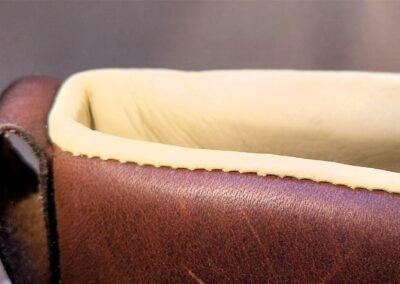
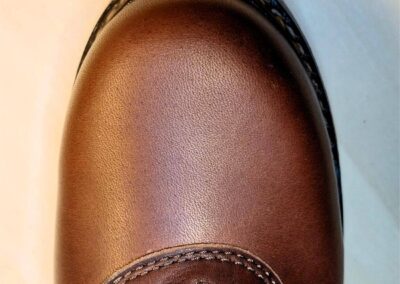
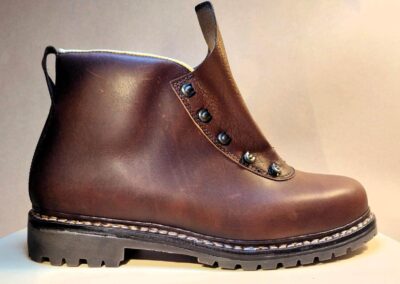
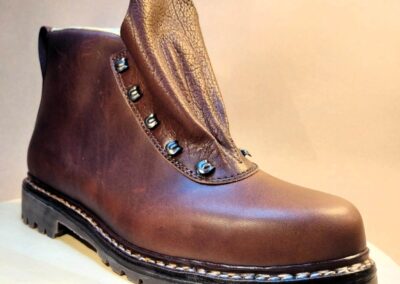
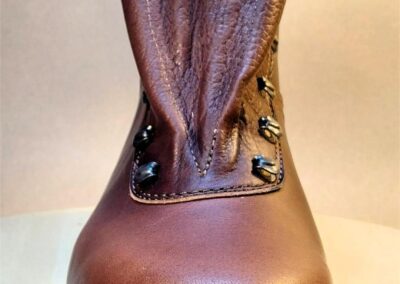
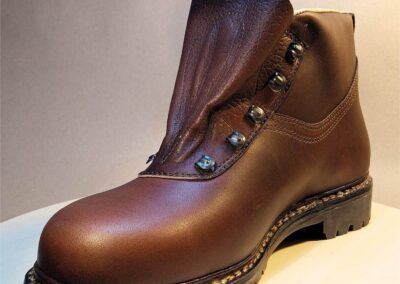
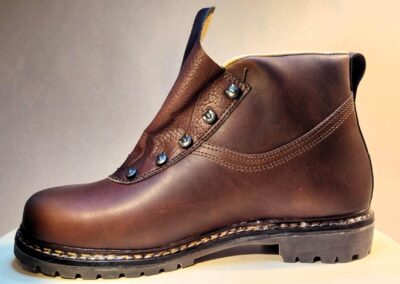
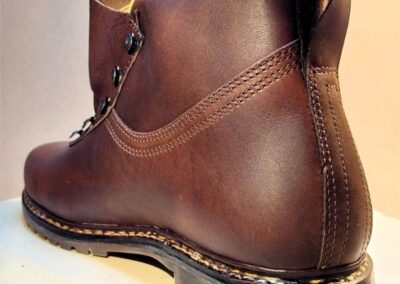
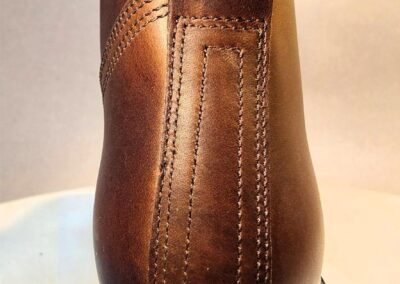
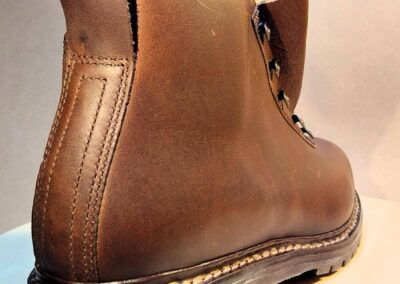
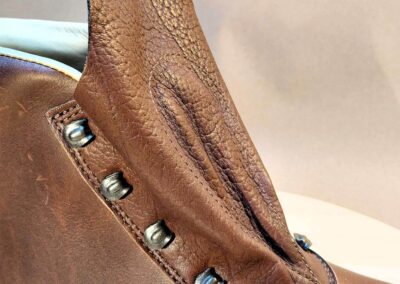

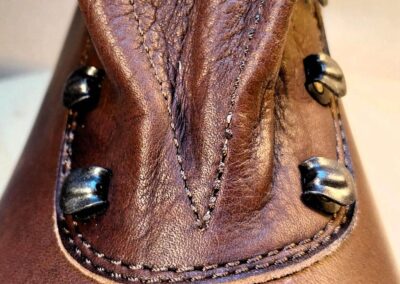
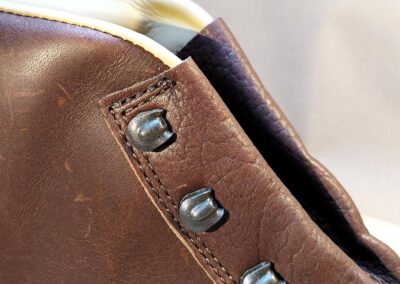


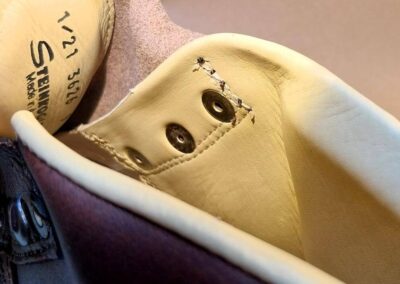
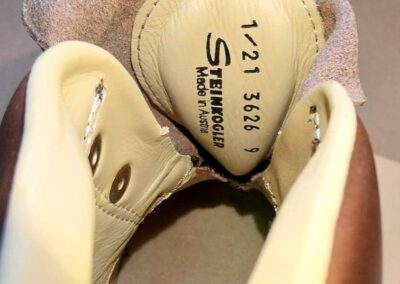
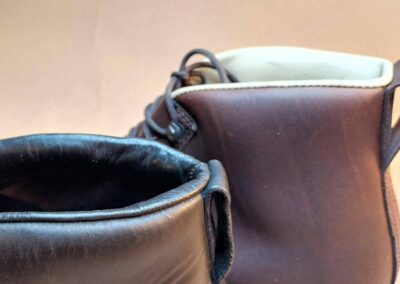
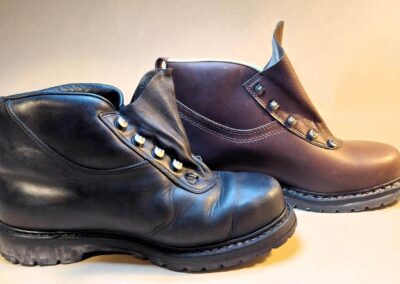
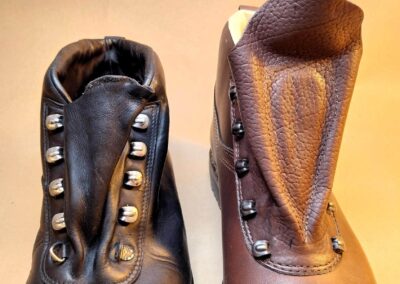
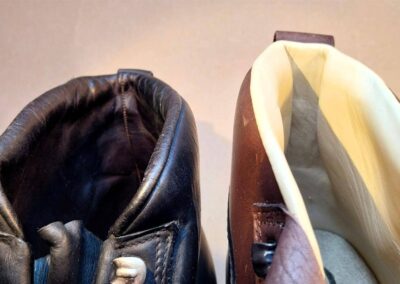

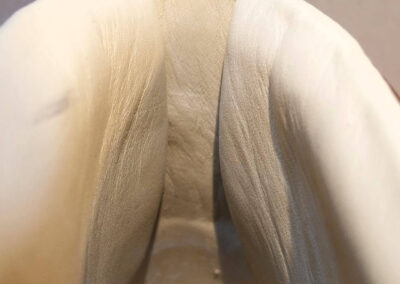
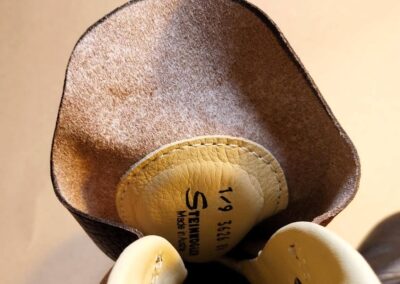
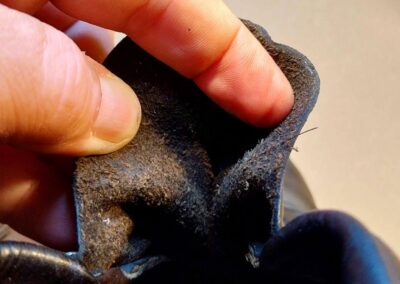
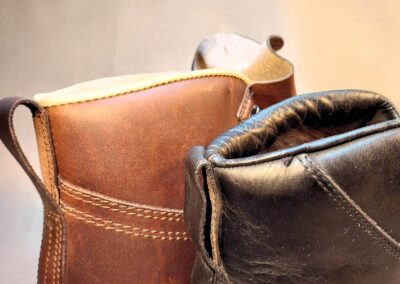
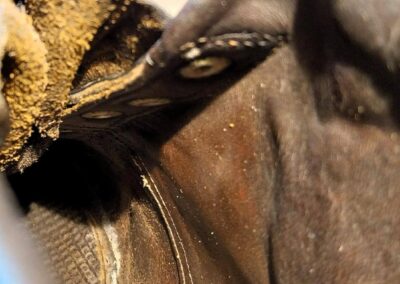
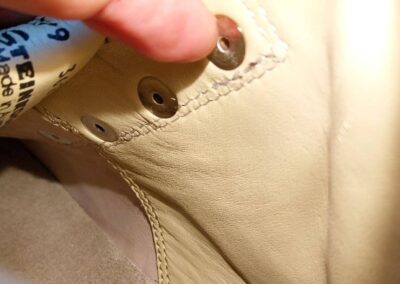
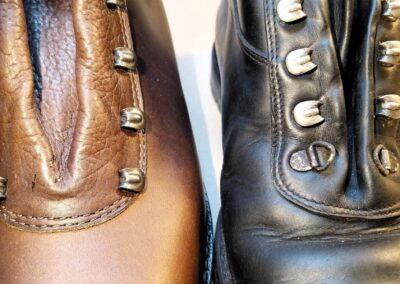
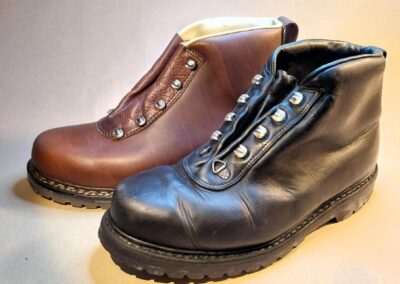
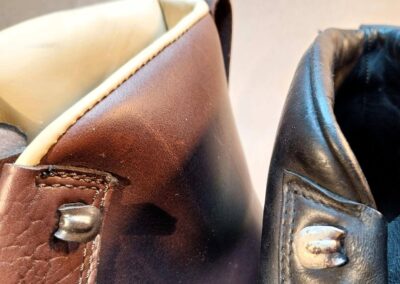
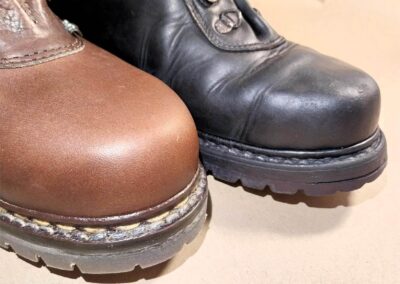
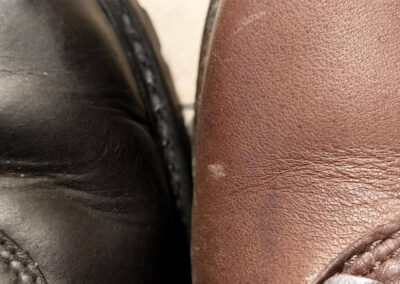
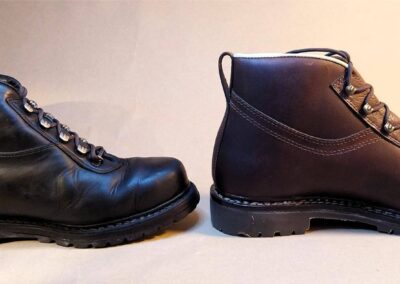
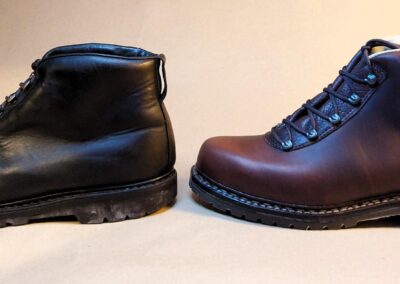
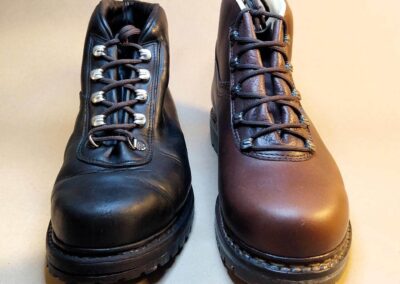
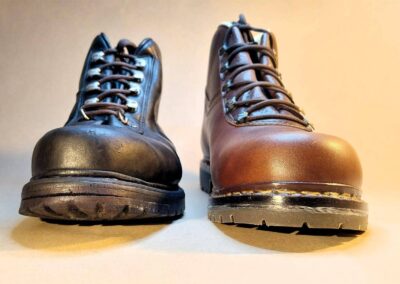
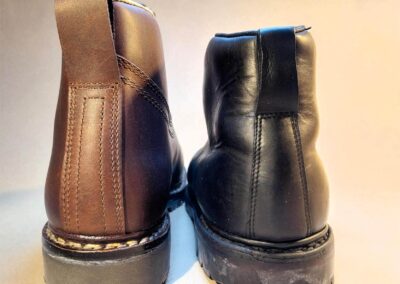
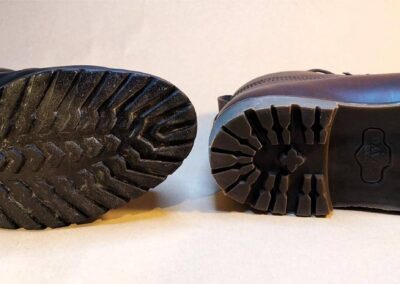
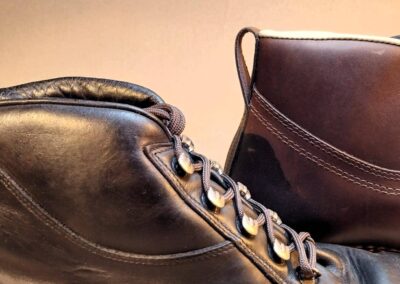
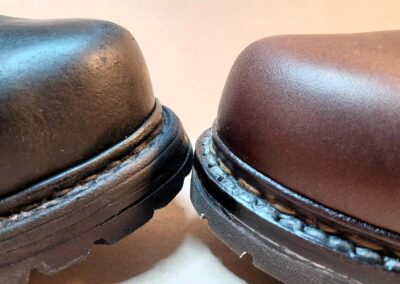
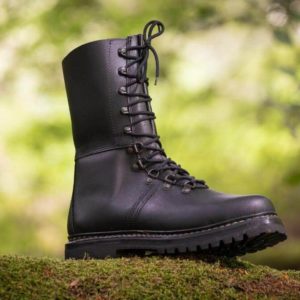
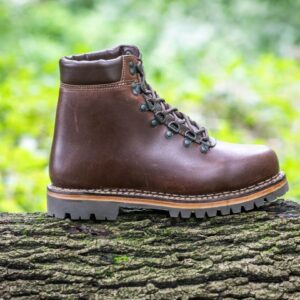
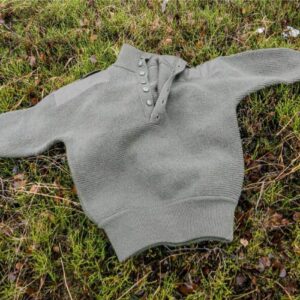
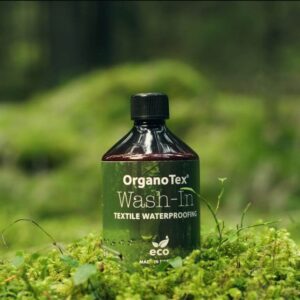
Guillaume, I had to answer to separate thread as it was getting slimmer and slimmer in width in the comment section. 🙂 We must think of a better solution next time so you guys can post more comments. 😉
Yes, it is great to have friends with different philosophy! I also have many ultralight friends. As long as we respect each other, it is great – I think we live in a great time, being able to pick any gear we would like, whether ultralight, or ultra-durable (and at rare times, they do cross over with each other!).
Good thing you are not going alone… when I was in Lapland, I was glad to be with a friend (he actually brought me there, so I owe him), in case anything happened in the wilderness.
Enjoy your trip, friend, and please write anytime!
Miro
Yes, wonderful era to choose the best equipement!
I also ordered the Steinkogler 2710, black, leather sole, for my everyday occupation in Paris. Do you have any information on these shoes?Still hard to find documentation, Steinkogler, come on!Be more talkative!:-)
Oh yeah, tell me about it! It seems we have more detailed descriptions than Steinkogler themselves. 🙂 But I respect that – they are excellent bootmaker and I am glad they devote their time to their craft and not product descriptions… that said, it complicates choosing for people.
I did not try 2710 myself, BUT we are preparing one of their city shoes at the moment, so yes, I think you have chosen well. I somehow cannot imagine any „wrong“ Steinkogler, and I hope we will never find such a boot. 🙂
Let me know how they work out for you!
And congrats – I also like my „office“ shoes to be quality and traditional. 🙂
Great!I will send you my own review after a mounth or two(if I can wait!:-).
I totally understand the fact that they spend more time on doing shoes rather than talking…It’s a good sign of quality over marketing. But for passionnate people it would be great to have more info…There is no video on youtube except yours:-)
Totally agree! It makes it hard for people interested in them (most people buying expensive leather boots are, in fact, interested).
I guess they have lot of larger contracts (army etc.) so they do not HAVE to put that much effort into promoting themselves, but still, it is a shame, right? On the other hands, it is good for our site. 😉 And we always take good care of people… but yeah, we do not have all the models in stock, not by far!
Let me know how they work out. If you want to send photos, I will be happy to take a look. 😉
Thank you again for your time writing all the comments!
Oh my god, the Lundhags park seems wonderfull!
Hello.
Yes Lundhags Park are great shoes.
Tom
Thanks for your reply Tom!
Komentář *
And thanks for the advices regarding the GTX. A lot of people seems to regret the choice of a goretex boots, other like it very much….It is quite strange and disturbing!
Well, sadly, as you said, it seems to be the case. However, it is fair to mention that for the first few months, GTX boots are very good – waterproof for the most part, often light, nimble, it just works.
But I don´t personally know of any friend (most of my friends DO wear GTX and modern boots), who would say something like:
„Yeah, I have had those GTX boots for 5 years now!“
It just never happens. A lot of them buy expensive modern boots (200-400 EUR), which last just 2-4 years at best, and they call it a good price/performance.
I am heavy proponent of traditional leather boots, BUT I respect that they might not always be the best choice and some models can be heavy. Price used to be a factor (more expensive than modern boots), but that does not seem to be the case anymore I guess – modern GTX boots often cost just as much as traditional leather boots.
I would also add an option – if you really have to have 100% dry feet, one option is quality rubber boots, like Le Chameau, Nokian and the like. You will have to change socks that WILL get wet from your sweat, but water will not get inside the boot from outside.
They are very good, also. But I prefer the feeling of leather boots and they have, so far, never let me down.
Hello Miroslav, thanks again. I also prefer traditionnal leather shoes. I ordered the Lundhags Park thanks to you; so I have the full spectrum with 3 pairs:
-traditionnal Steinkogler bergwacht(calf leather lined, will it act in humidity like a sponge?)
-full waterproof Harkila –Atamnik(with cordura opening for better ventilation and driing but hard to replace soles), very, very confortable
-Lundhags Park, the middle way, with rubber for waterproofness and simple layer leather for driing
, beetween traditionnal and modern!I will have a hard time to choise which one go with me to Scotland…!
Guillaume, this is great, you already have very nice boot roster (or shall I say army!)!
I am confident you will be happy with Lundhags… we know many friends who have them and I think only once or twice we had minor problem, which was easily and cheaply repairable. I still have mine after I think 5+ years now, heavy use especially in winter and wet autumn.
Bergwachts are excellent, but you are right – the inside CAN act like a sponge, it you spend enough days in wet swamps etc. while also sweating inside.
But it depends. My Limmer Lighweights are of VERY similar construction as Bergwacht. I wear them a lot, but most notable was in Swedish Lapland – moors, swamps, wet grass… no problem. But on the fifth day, I stepped into knee-deep swamp and water entered then via top. 🙁
But… they miraculously enough dried! I changed into sandals (it was cold, but still better than walking in wet-through boots), then when the water drained a little in the sun on my backpack, I put them back on and they mostly dried up by walking.
So it depends on your feet, how much you sweat, what the terrain and weather will be…
I would say, for Scotland in May, Lundhags Park will be the safest choice (or Harkila if you have good experience in wet weather with them!).
Let me know, I would be happy to help with eg. how to take care of Lundhags.
Also, you are in for a great trip to the Scotland, congratulations!
Good morning Miro and thanks for you very quick answer. I write in english and I guess your platform is automatically translating to Czhek. I don’t know the brand you advise me but I am pretty sure there are awsome, since I trust your opinion. I have a strong feeling of confidence, that your telling the truth!I use Saphir cream renovator for nourrishing my leather shoes, but for waterproofing I guess I need a grease, or a wax. What is the best for the steinkogler leather?Thank you very much, I really appreciate your time for answering me. Guillaume
Hello, Guillaume,
thank you for this excellent discussion! I am very happy to hear that I have helped and also your trust means A LOT to me. I apologize for this slower answer, I could not get to you sooner.
Yes, Lundhags is very solid Swedish brand, old-school, yet with modern twist thanks to the natural rubber parts… they are light, soft, yet slightly supportive (some models are, other are very soft, but I do not mind that). And waterproof to a high degree – lesser parts where the water can get in (it cannot get through natural rubber, only leather, and the few parts from leather can be greased with quality conditioners).
BTW, Saphir is excellent brand! You have great taste in quality.
For waterproofing, you are right, something more „heavy duty“ is needed. Excellent boot grease for waterproofing is eg.:
Limmer Boot Grease
https://limmerboots.com/products/limmer-boot-grease
Obenaufs Heavy Duty LP
https://www.obenaufs.com/heavy-duty-lp-p/leather-preservative-paste.htm
Lundhags Leather Grease
https://lundhags.com/eu/footwear/unisex/shoe-care/lundhags-leather-grease–1050111-000
And we also make boot grease:
https://festovniveci.cz/produkt/krem-na-kozene-boty/
(this one equally nourishes leather for long (10+ years) life and waterproofs to a high degree)
https://festovniveci.cz/produkt/100-impregnace/
And this one is hardcore heavy duty – I recommend it only for most leaky boots, and then ideally only on the seams, as it penetrates deeply into the leather and will dry it out eventually.
Please tell me if I have helped or you would like other recommendations. Love to chat!
With kind regards,
Miro
Perfect answer!I know understand that I should use two different greases, one for the main boot(waterproof but still breathable), one heavy for the stitching(waterproof as an Omega watch). Brilliant!
I have pure Lanolin at home for my skin but I will give it a try on the stitching. For the main upper part of the boot, I am considering ordering your „Magic cream“, and bring it with me when I travel so I can nourrish and protect my leather shoes on the trail
Thank you Guillaume, I am enjoying this discussion! Curious as to what will work out for you the best. Each boots are different a little, but generally boots with quality leather and as few stitches as possible can be highly waterproofed, especially OVER TIME.
So some boots are a little leaky from the start, even with quality materials… but after some time of greasing them well (not excessively, just regularly when they need it), they really sort of „shield up“ and the grease gets deep into the leather structure over time and it starts to be much better than in the begining.
My oldest boots (old Meindl Perfekts, I think about 12 years?) are much more waterproof than they used to be in the first few months.
Also, I would advise AGAINST Lanolin – it is great thing, but not for waterproofing seams I would say (we have tested it also).
Perhaps try some high quality cream (whether Limmer, Obenaufs, Lundhags or our „Magic“ ;)) first, apply slightly more on the seams and see. A lot of boots do not even need hardcore waterproofing for the seams…
My newest „Zero Drop“ boots were never taken care of by anything else than our cream and they are waterproof even in very wet grass and snow. At worst, my feet were slightly wet, but the shoe dried up by walking only – perfect.
Other than that, I do not want to recommend our product, but people are very happy with it (the Magic cream – thank you for the nice name :)). Sadly I am still sitting on a treasure trove of testimonials in my „to do list“, I admit…
Thanks Miroslav, I will NOT use my lanolin, I will follow your advice:-)
I also like this discussion; my friend comming to Scotland with me has another approach, he is smallest than me and prefer lightweight and modern equipement(he will go there with low trail running shoes). I told him about our discussion, and the difficulty to find the best compromise between respirability and waterproofness, comming tonthe conclusion that this notion is everywhere in biology and humanity(cell exchanges to nation borders…From technical stuff to philosophy…what a great blog :-). thanks again!
Hello sir!I appreciate your blog because I found the best information. It is hard to find documentation on Steinkogler. I have the bergwacht and I find it marvellous, a very good piece of mancraft. I hesitate between these and Harkila atamnik gtx to go for a walk in Scotland in may. My main concern is the humidity during a few days…Is leather will support the weather, or is it better to go modern with gore tex Harkilas….What is your opinion?Thanks and greatings from France. Guillaume
Hello, Guillaume,
thank you for the kind words! I am glad you like your Bergwachts – they are indeed very nice boots for a fair price, which should last you many years, if not a lifetime with resoling them every few years.
To your question – sadly, I do not use GTX boots anymore. Not in some „purist“ sense, but I did not have a good experience with many GTX boots over the years. Eventually they got wet anyway and the membrane lasted only some time (usually just a few months, sometimes only weeks!).
I kept the membrane clean, yet it still broke with usage and let water through, and my sweat could not get out – I never had such a smelly feet as I had back then. 🙂
But Harkilla is reputable bootmaker and they should last you some time in good service, even the GTX model. However, for May in Scotland, I would still try full leather boot.
My colleague (and founder of our project) would advise AGAINST leather boots for May Scotland (or any very wet weather), but my experience is different. I had several quality leather boots – Limmer Lightweight in Lapland wilderness (very wet for 12 days), my partner has her Dallapé Stivo boots usually for 2-3 weeks at a time in very wet mountains of Slovakia… and all good, occassionaly wet feet, but it dries while walking, never wet completely through.
However if you would like full leather boot without membrane and still be almost 100% sure of it being waterproof, maybe try Lundhags or Jorn Jensen boots. They are what people in Sweden/Norway/Finland use, and they have very wet natural areas, too, with moors, bogs, swamps everywhere. My Lundhags Park boots indeed serve me very well in wet snow, or autumn heavy rains in high grass.
What is most important is good quality leather + proper care (waterproof boot grease/conditioners). If you would like, I can recommend you some products (not only ours, there are other excellent brands, so I promise not to be biased ;-)).
Thank you for excellent question and your interest in us, despite probably having to use Google Translate (we have global site coming this year!).
With kind regards,
Miro